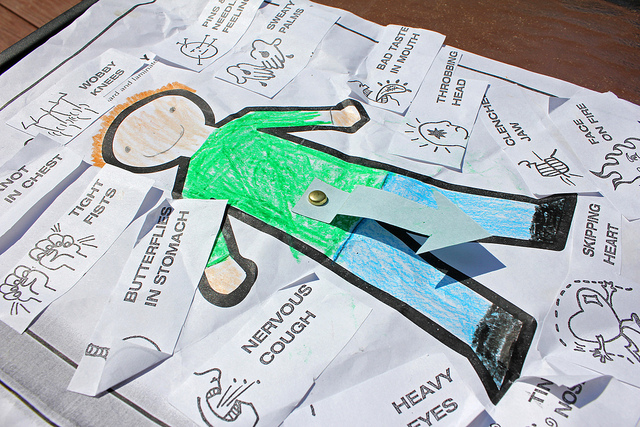
People who have never experienced a migraine for themselves often have trouble appreciating just how debilitating this condition can be. To help others understand the struggles you face as a migraine sufferer, you need to be able to describe your migraine symptoms and migraine pain in detail. Below is a guide and words bank to help you put your experience into words.
Retinal/Ocular Migraines
“I suddenly started to feel very off, like my vision was being dimmed.Then, I looked over at my wife and flashes of light surrounded her.”
When you experience a retinal or ocular migraine, you will typically have visual disturbances before feeling any migraine pain. The symptoms may occur as many as 18 hours before the pain begins. Visual disturbances usually occur only in one eye and may disappear before you start feeling the migraine pain. Visual disturbances associated with retinal migraines include:
-
Temporary blindness
-
Sensitivity to light
-
Decreased vision
-
Twinkling lights
Depending on your experience, you may also experience food cravings, mood swings, excessive yawning and other non-visual symptoms. If you have this type of migraine, you may describe the pain as throbbing or pulsating. It typically occurs on one side of the head, fluctuates with the rhythm of your pulse and becomes considerably worse with activity. For some sufferers, the pain is concentrated in one eye or temple instead of throughout the head. Migraine sufferers experiencing concentrated pain say that it feels like someone is drilling through their temple or retina. Retinal migraines may end within a few hours, or they may leave the sufferer in severe, tortuous pain for as long as three days.
Words to use when describing a retinal migraine: Rhythmic throbbing, pulsating, drilling
Basilar Migraine
“We were eating dinner, then all of a sudden she said her head was throbbing and could barely talk.”
Basilar migraines are one of the most frightening types of migraines you can experience. They often include debilitating symptoms, such as visual disturbances, loss of the ability to speak, confusion and loss of balance. The pain from a basilar migraine is severe and may be experienced on both sides of the head, as well in the back of the skull. It is often described as a severe throbbing, stabbing or aching. In the worst cases, sufferers have compared the pain of a basilar migraine to the feeling of having a scalpel stabbed repeatedly into the roof of the mouth.
Words to use when describing a basilar migraine: Throbbing, aching, stabbing, torture
Transformed Migraine
“It was a almost like a pulsing or steady type of pain. It reminded me of a really bad toothache I had as a teenager.”
Transformed migraines involve milder pain and may occur more frequently than other types of migraines. The migraine pain may also be accompanied by nausea, sensitivity to light and sensitivity to sound. Depending on your experience, you may have pain on both sides of the head or on only one side. You may also experience the pain as a constant sensation or as a throbbing. For some sufferers, transformed migraines feel very similar to tension headaches. Other sufferers have compared the pain of a transformed migraine to a toothache or a tightness in the head that cannot be relieved.
Words to use when describing a transformed migraine: Throbbing, aching, steady ache, pulsing, tension
Silent Migraine
“There might have been no traditional migraine pain, but the sensitivity I had to light was unbearable. It was like the sun was right in front of me.”
Silent migraines are migraines that occur without pain. However, these migraines can bring other debilitating symptoms in place of the pain, including confusion, visual disturbances, sensitivity to light, sensitivity to sound, nausea and other frustrating conditions.
Words to use when describing a silent migraine: Nausea, light sensitivity, sound sensitivity, blindness, blurriness, confusion
Hemiplegic Migraine
“I was so scared my mother was having a stroke. Her speech was slurred, she almost lost conscious and mumbled her arm was tingling.”
A hemiplegic migraine is a severe subtype of migraine that can simulate a stroke. Symptoms may begin before the migraine pain starts, or they may occur simultaneously. These symptoms often include nausea, slurred speech, confusion, loss of consciousness, tingling up the arm, dizziness and numbness. The pain is typically experienced on one side of the head as a severe throbbing or stabbing. The nausea from a hemilplegic migraine is often compared to the stomach flu.
Words to use when describing a hemiplegic migraine: Throbbing, stabbing, numbness, tingling, pins and needles, stomach flu
Final Thoughts
Although medical professionals do their best to define various types of migraines, each sufferer’s experience is different. If you have migraines, you may find that your migraine pain doesn’t fit perfectly into any one category. For example, while some sufferers with visual disturbances may experience a typical retinal migraine with one-sided pulsing pain, others may experience pain on both sides of the head. Still others may feel dull, constant pain all over the head with a severe throbbing in the eyes or temples. When relating your experience to others, use the words that best fit your pain, and don’t be afraid to include descriptions from more than one of the word banks above.
Do you have anything to add to our description of these types of migraines? Share your additions in the comment section below and help others relay their emotional and physical pain.
Image Source: woodleywonderworks

